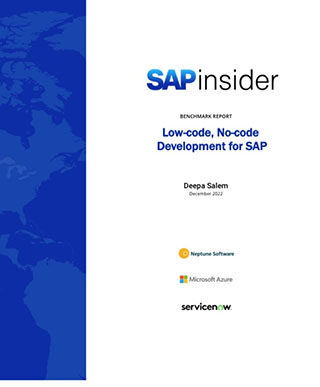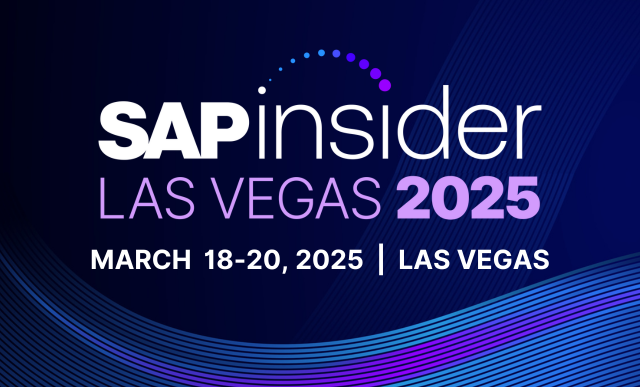SAP Integration Suite Uplift
Meet the Experts
A strategic model by cbs Corporate Business Solutions to drive the migration from SAP PI/PO to SAP Integration Suite – Why and How.
Today, the well-established installations of SAP Process Integration and SAP Process Orchestration most companies have as their central integration platform are approaching important changes. SAP noticed a need for evolution in the technology for integration of increasingly heterogeneous system landscapes. In accordance with the announced SAP NetWeaver 7.5 end-of-life, December 31st of 2027 is the date until which SAP will continue to maintain the latest release of SAP PO, with the option of extended maintenance until the end of 2030. Forward-thinking is now crucial as these deadlines approach and having the right methodology for this transition is a key differentiator for the time to come.
The system and process landscapes have changed rapidly in the recent years and for quite some time now the usage of cloud applications has become the norm. At this time, it is likely to have applications like Salesforce, S/4HANA Cloud, SAP SuccessFactors and SAP Ariba integrated in the traditional SAP system landscape. This leads to changed integration requirements. SAP Integration Suite is the platform recommended by SAP for modern integration, developed to address these new requirements and thought to second the future trends of our industry.
Explore related questions
SAP Integration Suite is the new strategic enterprise-grade integration platform as a service (iPaaS) by SAP for all integrations in hybrid system landscapes. It is a completely cloud-based platform as a service offering.
SAP Cloud Integration – the most important component in the integration suite – is a cloud-based middleware platform which offers all features you would expect from a middleware: There are adapters for many standard protocols, different mapping technologies and means for message routing, splitting etc. It has a much more flexible pipeline than SAP PI/PO which allows you to implement many scenarios more easily than on SAP PO.
SAP API Management allows you to publish internal and external APIs in a central API catalog, to centrally monitor APIs and to apply additional logic, like security checks or caching for frequent requests and responses, before the calls are forwarded to the target application.
Integration Advisor creates mapping proposals for common integration scenarios based on existing integration knowledge/mappings and AI-based algorithms. This can reduce development efforts in the area of Business-to-Business (B2B) scenarios and avoid implementing the same mapping repeatedly.
Event Mesh allows you to link applications through asynchronous events. Connect the core SAP systems, SAP SaaS and other third-party applications with the open CloudEvents specification for responsive, scalable and decoupled business notification exchanges.
In addition, there is SAP Open Connectors, which is a collection of third-party connectors for specific applications or services, like Microsoft SharePoint, Amazon S3 and Workday. These connectors can simplify the interface development process and save time on the detailed technical configuration.
SAP provides pre-packaged content for many standard integration scenarios. These are downloadable integration packages which can be used directly or be used as a basis for custom developments. New SAP standard content is only released for SAP Integration Suite and no longer for SAP PO.
Our recommendation is to implement new interfaces directly on the SAP Integration Suite, and there is a number of reasons why:
- To familiarize with the new platform in an early stage
- To avoid a rushed migration from SAP PI/PO later
- To benefit from the more flexible pipeline in SAP Cloud Integration, which makes the development of complex integration scenarios easier
- To allow time for companies’ internal workforce to get acquainted with the new SAP integration paradigms and tools
- To utilize the SAP standard integration content where possible
In order to start providing APIs sooner than later, it is a good idea to start now with SAP API Management as well, and publish APIs for selected scenarios. The barrier to use SAP API Management will be much lower in the future if the platform is already in place.
We offer our cbs Integration Suite Uplift solution to support the most efficient journey to SAP Integration Suite possible.
The core of the offering is the Transition Pre-Study:
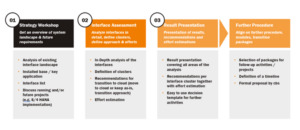
It starts with a strategy workshop to get an overview of your system landscape, key integrations, future integration requirements and current pain points.
In the next phase, we conduct an assessment of all the interfaces in your landscape. We analyze your current integrations based on your interface inventory and directly in your SAP PI/PO system.
The insights from our analysis are summarized in the result presentation. It will comprise our recommendations for the transition approach segregated by interface area, effort estimations, a proposed timeline, and other KPIs to consider in the transition to SAP Integration Suite. Also, we discuss how cbs Corporate Business Solutions can support you in the further process.
Besides the pre-study, you can choose from many ready-to-use-modules, like integration & API strategy definition, guidelines & best-practices definition, project management support, training program, support, agile prototypes with SAP Cloud integration and API Management and more.
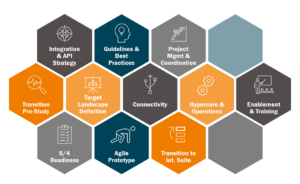
We identify several different approaches to move the interfaces to the cloud:
- As-Is Migration: In this approach we are going to reuse as much as possible by importing data structures and mapping from SAP PO. The effort of this approach is the lowest as it preserves most of your pre-existing investments.
- Fit 2 Technology: in some cases, we must change the interface in regard to technical aspects without redesigning the process. Examples are java mapping, which must be replaced by groovy scripts and the replacement of adapters with better options.
- Redesign: the approach with the highest effort is a functional redesign of an interface. This approach should be chosen if an existing interface causes many issues or is not applicable anymore due to changes in the landscape.
- Replace: The last approach is to replace an interface with pre-packaged content from SAP or a set of APIs without having to migrate the interface in the Cloud Integration.
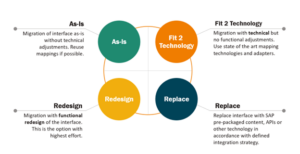
We have completed many projects using SAP Integration Suite in the past few years and have deep experience with the platform, allowing us to develop best practices for moving interfaces from the on-premise integration platform to the cloud. Our experience working with over 70% of world market leaders in Manufacturing, Chemicals, Life Sciences and Automotive provide us with valuable insights to ensure projects are on-time and on-budget with minimal disruption to operations.
Today we are only 5 years away from 2027, the end of SAP PO. The above mentioned 2030 extended maintenance is used by most companies as a contingency, rather than a deadline. Either way, the journey to SAP Integration Suite should start as soon as possible, in order to ensure enough time to build a business case, estimate the implementation timing and lock in a reliable system integrator partner as in the years to come the demand will surpass the offer and increase the costs.





